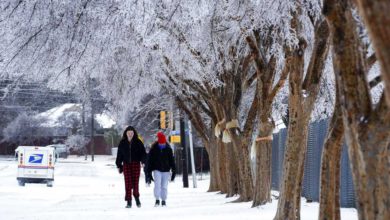
It's fall. The leaves are changing, the days are getting cooler and ... are the insects really bad?
If you've noticed an uptick in activity and general annoyance from insects of a stinging variety – mainly yellow jackets, bald-faced hornets and paper wasps – you're not alone.
"It's not imaginary," said Joe Boggs, an entomologist with Ohio State University's Buckeye Yard and Garden Online. "The populations are very high."
Boggs is careful to note that while they do sting, yellow jackets, bald-faced hornets and paper wasps are beneficial insects on the balance, thanks to their eating of plant pests.
"Their behavior is only bad late in the season," he added.
Stink bugs are everywhere. How to keep them out of your home and get rid of them
Why are there so many out right now?
At this point in the season, Boggs said all insects in yellow jacket, bald-faced hornet and paper wasp hives have completed development, and colonies are at their maximum size, leading to increased activity in and outside their homes.

Soon, queens and drones from the hives will fly off and mate, and the queen will go to find a protective location to survive the winter. After the queen leaves and the weather turns colder, Boggs said eventually every insect left in the hive will freeze to death.
"Their Achilles' heel is the winter," Boggs said. "The entire nest dies, so it's really a matter of waiting them out. If you have a problem right now, you can just wait and let nature take its course."
These nests only last one season and new nests will pop up in the spring, depending on where the new queen starts one, and Boggs said they are seldom near the location where the queen grew up.
The number of yellow jackets, bald-faced hornets and paper wasps each year is also dependent on the severity of previous winters as well as how many queens were able to survive and produce new colonies the following spring.
More:Are you seeing more acorns falling? You could be in the middle of a 'mast year'
More:Fall armyworms march across Ohio and Kentucky, causing damage to crops and grass
How to tell the difference between yellow jackets, bald-faced hornets and paper wasps
All three species are under the category of social wasps that produce colonies each year with only the malted queen surviving the winter, according to Plunkett's Pest Control.

Yellow jackets are the smallest of the three, at around a half-inch in length and are often mistaken for honeybees because of the yellow markings on their bodies. Their nests are often found below ground.

Bald-faced hornets are around three-quarters of an inch long, with black bodies and gray bands. Their nests are typically large and enclosed, containing over 100 hornets inside.

Paper wasps are around 1-inch long with long legs and can range in color, from reddish-orange to black, sometimes with yellow highlights. Their nests are typically umbrella-shaped and have fewer than 100 wasps in a colony.
Will they sting?
While busy, these insects are mainly searching for sugar to bring back to the hive to use as food and are typically not aggressive when encountered outside their homes.
However, disturbing the hive is a different story, Boggs said. Yellow jackets, bald-faced hornets and paper wasps are able to sting multiple times unlike European honeybees, and are most aggressive when defending their nests.
"If you go after the nest, they will literally fight to the death," Boggs said.

If you do need to remove a nest and can't wait until the winter, Boggs recommends getting help from a professional, rather than attempting it yourself.
When will they start to die off?
After the queens leave the hive to survive the winter, the rest of the nest typically begins the process of declining after the first frost, Boggs said. The first frost of the year won't totally eliminate them, but it will knock them down. By the dead of winter, most hives have usually died out.
"It takes freeze after freeze," Boggs said. "But when that's going to happen, we're never really sure."
More:Is that a murder hornet in your yard? Here's what to do
Plant Lovers’ Almanac: Stink bugs, lady beetles and other fall invaders can be a nuisance
What about bees?
Honeybees may also be more aggressive in the fall as they are more productive, preparing for the winter ahead.
Unlike yellow jackets, bald-faced hornets and paper wasps, bees do not die in the winter, and typically stay alive by staying inside their hive and feeding on honey created throughout the year.
Bees are also beneficial to the environment around them, acting as pollinators for many flowers and food crops.
For decades scientists have been watching the population of pollinators — crucial to the world’s food supply — shrink. Honeybees, the most easily tracked, are threatened by mites, diseases, pesticides and loss of food, the Associated Press reported.
More:Honeybees in America are doing better after a bad year, survey shows
Source link







